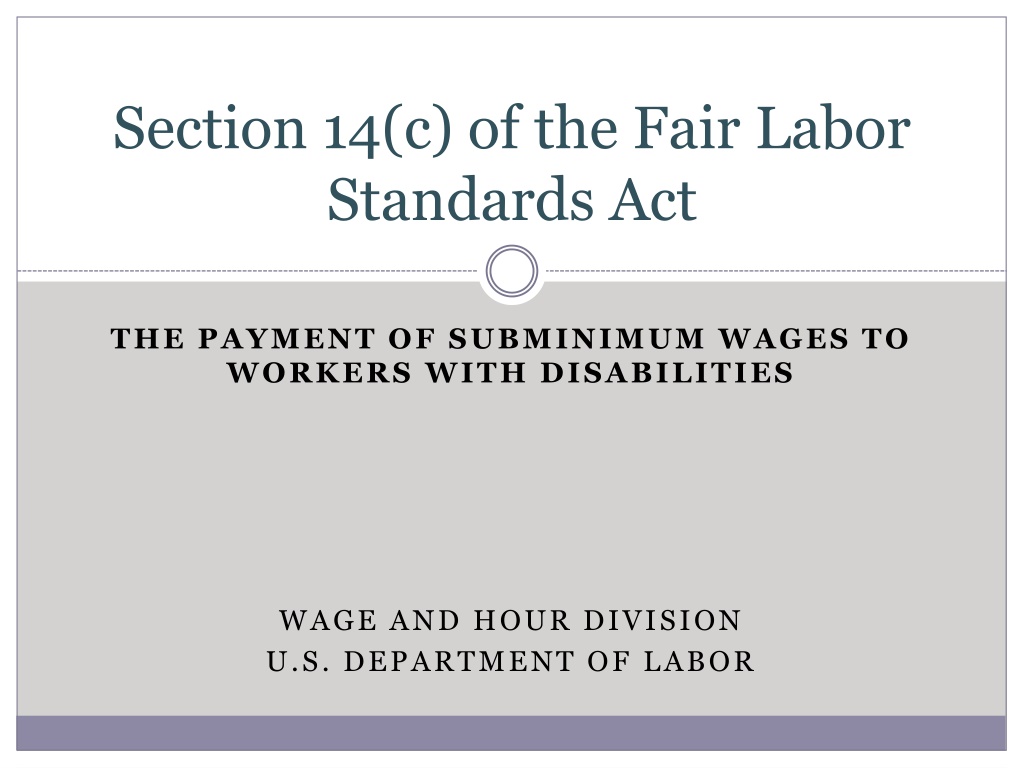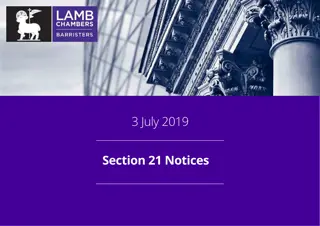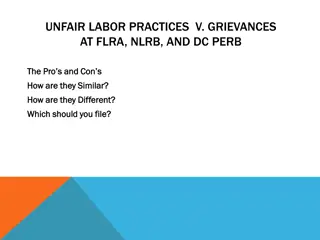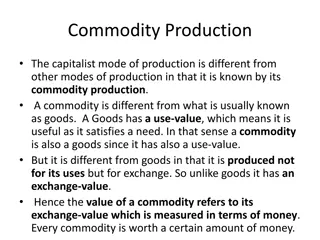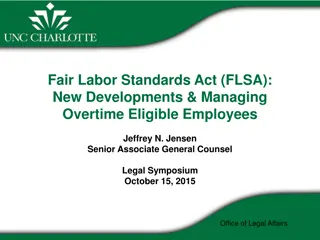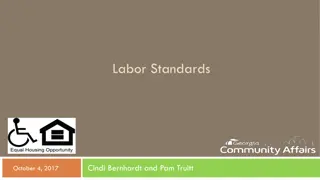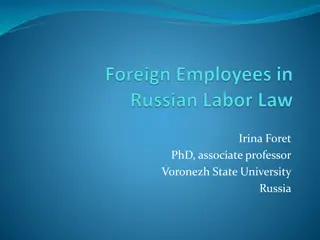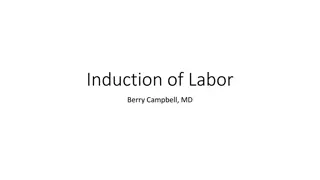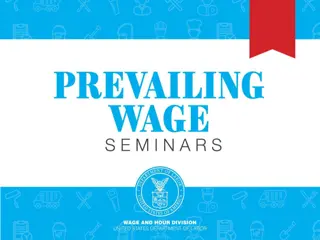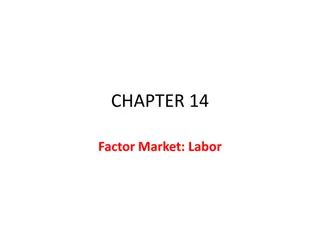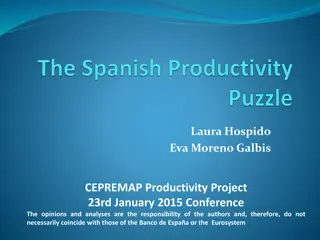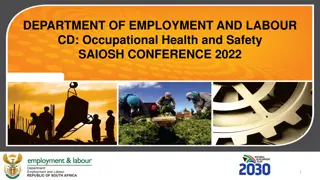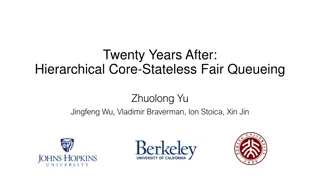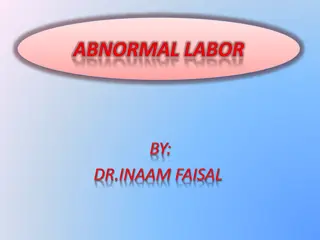Understanding Section 14(c) of the Fair Labor Standards Act
Section 14(c) of the Fair Labor Standards Act allows for the payment of subminimum wages to workers with disabilities when their productivity is impaired. The Wage and Hour Division of the U.S. Department of Labor oversees compliance with this provision, aiming for a vigorous and effective program. The presentation emphasizes key aspects such as coverage, employment relationship, certification process, record requirements, and interaction with related federal laws. It highlights the authorization for employing workers with disabilities at subminimum wages based on their impaired productivity, ensuring that the wage is commensurate with their abilities.
- Fair Labor Standards Act
- Subminimum wages
- Workers with disabilities
- Wage and Hour Division
- Compliance program
Download Presentation

Please find below an Image/Link to download the presentation.
The content on the website is provided AS IS for your information and personal use only. It may not be sold, licensed, or shared on other websites without obtaining consent from the author. Download presentation by click this link. If you encounter any issues during the download, it is possible that the publisher has removed the file from their server.
E N D
Presentation Transcript
Section 14(c) of the Fair Labor Standards Act THE PAYMENT OF SUBMINIMUM WAGES TO WORKERS WITH DISABILITIES WAGE AND HOUR DIVISION U.S. DEPARTMENT OF LABOR
The Wage and Hour Division (WHD) It is the responsibility of WHD to carry out a vigorous, consistent, and effective compliance program with respect to employment of workers with disabilities under this provision
Disclaimer The presentation is intended as general information only and does not carry the force of legal opinion. The Department of Labor is providing this information as a public service. This information and related materials are presented to give the public access to information on Department of Labor programs. You should be aware that while we try to keep the information timely and accurate, there will often be a delay between official publications of the materials and the modification of these pages. Therefore, we make no express or implied guarantees. The Federal Register and the Code of Federal Regulations remain the official sources for regulatory information published by the Department of Labor. We will make every effort to keep this information current and to correct errors brought to our attention.
Topics of Discussion Section 14(c) Provisions Establishing Coverage The Employment Relationship Determining Hours Worked The Certification Process The Process to Determine SMW Record & Notice Requirements Interaction with Related Federal Laws WIOA, SCA, & Executive Orders Common Errors
Section 14(c) Provisions Statute Key Terms Regulations
Section 14(c) of the FLSA Authorizes the employment of workers with disabilities at subminimum wages when their disabilities impair their productivity for the work being performed See 29 U.S.C. 214(c)
Subminimum Wage (SMW) A SMW can be paid to workers with disabilities when their disability impairs their productive and earning capacities for the work being performed SMW must be commensuratewith the workers productivity as compared to the wage and productivity of experienced workers who are not disabled for the work SMW can only be paid when authorized by a certificate issued to the employer by DOL
Worker With a Disability Worker whose earning or productive capacity is impaired (by age, physical, intellectual/ developmental, or psychiatric disability, or by injury) for the work to be performed Although a disability may affect a worker s earning or productive capacity for one type of work, the same disability may have no impact on that worker s ability to perform another kind of work Employers remain responsible for compliance with all other labor laws, including the Americans with Disabilities Act and the Rehabilitation Act
Community Rehabilitation Program (CRP) Provides rehabilitation services, day treatment, training, and/or employment opportunities to individuals with disabilities CRPs commonly refer to workers with disabilities who are employed pursuant to a section 14(c) certificate as consumers
Regulations 29 CFR Part 525 Set forth the conditions and terms governing the employment of workers with disabilities at subminimum wages
Key FLSA Concepts Coverage Employment Relationship Hours Worked
FLSA Enterprise Coverage A firm with at least a $500,000 annual dollar volume (ADV) of sales or business done that has at least two employees handling, selling or otherwise working on goods or materials moved in or provided for commerce O R A for-profit or nonprofit firm engaged in the operation of a: hospital; nursing home/group home; school for children with physical, intellectual/developmental, or psychiatric disabilities; public or private elementary or secondary school or institution of higher education; or preschool A Federal, State, or local government agency
FLSA Individual Coverage An employee is covered individually if he or she is engaged in: Interstate commerce OR The production of goods for interstate commerce OR Work that is closely related and directly essential (CRADE) to such production But only for the workweek in which those covered activities occur
An Employee Under the FLSA FLSA Definitions Employee = any individual employed by an employer Employ = to suffer or permit to work Time spent by an individual at a CRP receiving services does not have to be paid under the FLSA
Patient Worker An individual with a disability who receives treatment at a hospital or residential care facility and is employed by that same hospital or residential care facility Treatment may be received on an inpatient or outpatient basis A patient undergoing evaluation or training is not considered to be an employee during the first three months spent in work activities, if certain criteria are met
Patient Worker (continued) Whether an employment relationship exists depends in part on whether the work performed is of any consequential economic benefit to the institution Examples of work frequently done that are of consequential economic benefit include building maintenance, office work, and janitorial work An employment relationship does not exist when the patient volunteers to perform services that the institution would not pay for if performed by someone other than the patient, such as helping another patient in a wheelchair get around, or tending a vegetable garden for the patient s own use
Participants in Substance Abuse Programs An individual enrolled in a substance abuse recovery program may be classified as a patient worker if employed by the facility providing the treatment An employment relationship under the FLSA will not exist for the first four weeks (28 consecutive calendar days) of residence at the facility so long as the individual does not engage in activities that provide a consequential economic benefit to the facility Special provisions apply to participants in programs that are placed in family setting style residential care facilities
Volunteers Workers with disabilities may volunteer to perform certain tasks for the not-for-profit CRP without creating an employment relationship if: The worker is legally competent to freely volunteer (or, when appropriate, his or her parent or guardian approves) The task performed is substantially different from work that the individual performs during duty hours The task is performed outside normal duty hours The task is of the type that would normally be classified as volunteer work The task is not part of the business or commercial activities of a non-profit organization
Hours Worked The FLSA concept of hours worked determining when an employee is performing work for which he or she must be compensated applies to workers with disabilities who receive subminimum wages All time spent at a CRP by an individual may not be compensable (such as the time he or she spends in counseling, personal care, recreation, etc.)
Down Time Workers with disabilities are required to be paid for down time when the worker with a disability is on the job but is not producing because of factors not within his or her control, including: lack of work equipment breakdowns
Extended Down Time Rehabilitation services provided to individuals during periods of extended down time, need NOT be considered compensable when: The services provided are not primarily for the purpose of increasing job productivity The services are provided away from the production area Time is clearly identified, recorded, and segregated on time records
Work Samples and Work Simulations Work samples and work simulations are types of rehabilitation activities structured to resemble the work performed in the employer's facility and need not be considered compensable when: Performed away from the production area Completed product is not used to fulfill any of the employer's contracts The employer does not derive any economic benefit from the product Supervised by non-production personnel They are a specific part of a well-defined program of rehabilitation None of the products enter into commerce by being intermingled with the normal production of the employer
Travel Time Time spent to and from the work site and home at the beginning and end of the day is not considered hours worked This principle applies even when the transportation is provided by the employer for the benefit of workers with disabilities Time spent in transportation between job sites during the course of the workday is considered hours worked and the employee must be compensated for that time
Rest Periods and Breaks The FLSA does not require rest periods or breaks Breaks between 5 and 20 minutes are considered to be primarily for the benefit of the employer and are considered hours worked and are compensable Workers with disabilities who are paid on an hourly basis must be compensated for such breaks Worker with disabilities who are paid piece rates are NOT required to be compensated for such breaks, when the piece rate calculation includes a sufficient allowance for personal time, fatigue, and unavoidable delays (PF&D)
Recording Hours Worked The FLSA requires employers to keep records of both the daily and weekly hours worked 29 CFR Part 516 The employer must clearly distinguish in its records non-compensable hours from hours that would be considered hours worked
14(c) Certification Only employers who have applied for and received a certificate from the Wage and Hour Division may choose to pay SMWs to workers who are disabled for the work being performed The granting of a certificate is NOT a statement of compliance by the Wage and Hour Division Certificates will NOT be issued retroactively
Types of Establishments WHD issues 14(c) Certificates to: Community Rehabilitation Programs (CRPs) 2 year certificates Establishments that employ patient workers 2 year certificates Business establishments 1 year certificates School Work Experience Programs (SWEPs) 1 year certificates
Establishments that Employ Patient Workers If the facility operates a work center, it must apply for a separate certificate for the work center If the facility places patients in jobs at business establishments in the community, it must either obtain a work center certificate or ensure that the business establishments have their own certificate
Business Establishments If an individual with a disability is placed at a business by a CRP, is supervised by CRP staff, and is carried on the CRP s payroll (e.g., supported employment worksites, enclaves) the business establishment need not obtain a certificate The authorization to pay SMWs will stem from the certificate held by the CRP
School Work Experience Programs (SWEP) Schools with SWEP programs place students with disabilities at work sites in the community The community-based employer may pay students with disabilities SMWs if the school has a current section 14(c) certificate Certificates are issued to the schools administering the SWEP, not the businesses at which the students are placed
How to Apply for a Certificate Employers wishing to obtain a section 14(c) certificate must either: Complete WHD forms WH-226 & WH-226A and mail to the Certification Team in Chicago, or Complete the online application. Instructions are included with the forms and in the online application system for help in understanding the data collection required.
Online Certificate Applications Users can submit a new application and see the account s online application history Applications can be started and progress saved to continue at another time Based on answers provided, the system will determine what information is required for a complete application A review and submit screen will identify any required fields left blank Upon submission, the user will receive an on-screen and email confirmation of the submission
Paper Form Certificate Applications Employers wishing to apply by mail must complete both forms WH-226 and WH-226A WH-226: application WH-226A: supplemental sheet for each physically-separate location or worksite where workers with disabilities will be employed at subminimum wages Completed applications should be mailed to: U.S. Department of Labor, Wage and Hour Division 230 South Dearborn Street, Room 514 Chicago, Illinois 60604-1591
Certification Attestations Every applicant must attest that: The employer has read the application form and to the best of his or her knowledge and belief, all answers and information given in the application and attachments are true The representations set forth in support of the application to obtain or continue the authorization to pay workers with disabilities at subminimum wage rates are true The authorization to pay SMWs, if issued or continued, is subject to revocation in accordance with the provisions of 29 CFR 525 Workers employed (or who will be employed) under the authority in 29 CFR 525 have disabilities for the work to be performed Wage rates paid (or which will be paid) to workers with disabilities under the authority in 29 CFR 525 are commensurate with those paid experienced workers, who do not have disabilities that impair their performance, in industry in the vicinity for essentially the same type, quality and quantity of work
Certification Attestations (continued) The operations are (or will be) in compliance with the FLSA, the Walsh-Healey Public Contracts Act (PCA), the McNamara-O Hara Service Contract Act (SCA) and the Contract Work Hours and Safety Standards Act (CWHSSA), an overtime statute for Federal contract work No deductions will be made from the commensurate wages earned by a patient worker to cover the cost of room, board or other services provided by the facility Records required under 29 CFR 525 with respect to documentation of disability, productivity, time studies or work measurements, and prevailing wage surveys will be maintained The wage rates of all hourly rated employees paid in accordance with FLSA section 14(c) will be reviewed at least every six months Wages paid to all employees under FLSA section 14(c) will be adjusted at periodic intervals, at least once a year, to reflect changes in the prevailing wage paid to experienced workers employed in the vicinity for essentially the same type of work
Application Processing To expedite the certification process, employers should: Designate an individual within their organization who understands both the certification and compliance principles of FLSA section 14(c) to oversee the completion and submission of the application Submit a complete, accurate, and timely application that includes all the required supporting documentation Communicate with the WHD Certification Team as needed before, during, and after the submission of the application
Application Processing (continued) WHD Wage Specialists review each application for completeness, accuracy, and compliance with the provisions of section 14(c) Once the review is complete, a certificate will be issued or denied Issuance of a certificate is not a statement by the Wage and Hour Division that the employer is in compliance with the provisions of the applicable Acts and does not provide the employer with a good faith defense should violations later be found
Denial of Application A certificate will be denied if the application is incomplete, contains false statements, or does not include the proper supporting documentation and attestations If denied, the applicant will be advised in writing and told the reasons for the denial, as well as the right to petition for review
Certificate Expiration Certificates are issued with both an effective date and an expiration date Certificates, along with the employer s authorization to pay SMWs, expire on the indicated date unless the employer properly files an application for renewal with the Wage and Hour Division before the expiration date
Certificate Renewal The employer is responsible for filing a proper and timely renewal application prior to the expiration of its certificate. Renewal applications are submitted in the same manner as an initial application but require additional information .
Certificate Revocation A certificate may be revoked by the Administrator of WHD for the following reasons: It is found that false statements were made or facts were misrepresented in obtaining the certificate. If this is the case, the certificate may be revoked back to the date of issuance. It is found that the certificate holder violated any of the provisions of the FLSA or the terms of the certificate. If this is the case, the certificate may be revoked back to the date the violations began. It is determined that the certificate is no longer necessary to prevent the curtailment of employment opportunities for workers with disabilities. If this is the case, the certificate will be revoked as of the date of the employer revocation notice. A petition for review may be filed with the Administrator within 60 days of the action
Certification Questions Contact the Certification Team at (312) 596-7195
DETERMINING A SUBMINIMUM WAGE 1) Develop a Job Description 2) Determine the Prevailing Wage 3) Define the Work 4) Establish the Standard 5) Measure the Worker 6) Calculate and Implement Rate of Pay
Job Description A job description is important when determining the prevailing wage and when setting the standard upon which the subminimum wage will be based A detailed job description should: Define the specific job duties, responsibilities, and tasks Identify the types of equipment and supplies used to perform the tasks List the types of skills, education, or experience levels required Indicate the location and days and times of the week the work will be performed Define and establish the minimum acceptable levels of quantity (how much production must be accomplished) and quality (how well the job must be performed)
